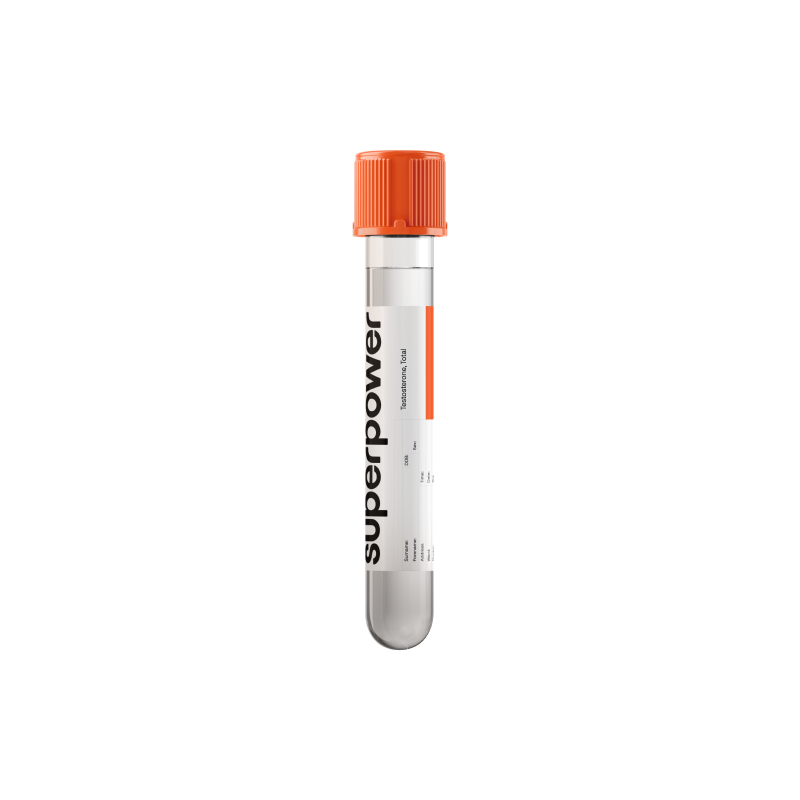Testosterone is a hormone that is mainly produced by the testicles in males and the ovaries in females, but also by the adrenal glands in both sexes.
It is responsible for sexual and reproductive development, sex drive, muscle mass, bone health, mood and energy levels.
Key Benefits
- Check your body’s testosterone level to assess androgen balance and health.
- Spot low testosterone as a cause of fatigue, low libido, or weakness.
- Flag androgen excess causing acne, hair growth, or irregular periods, often from PCOS.
- Clarify fertility risks when testosterone is low or suppressed by steroids.
- Guide treatment choices by confirming deficiency before starting or adjusting testosterone therapy.
- Protect bone health by identifying chronic low testosterone linked to osteoporosis risk.
- Track trends reliably by testing in the morning and repeating abnormal results.
- Best interpreted with free testosterone, SHBG, LH, FSH, and your symptoms.
What is Testosterone, Total?
Testosterone, total, is the body’s principal male-type sex hormone (androgen). It is a cholesterol-derived steroid produced mainly by Leydig cells in the testes, with smaller amounts from the ovaries and adrenal glands in all sexes. In the bloodstream, most testosterone travels attached to carrier proteins—sex hormone–binding globulin and albumin—while only a small portion circulates unbound. “Total testosterone” is the sum of the free hormone plus the protein‑bound fractions.
Testosterone drives male sexual development, supports libido and erectile function, and enables sperm production (spermatogenesis). It also helps maintain muscle mass and strength, preserve bone, and stimulate red blood cell production (erythropoiesis). In the brain, it influences mood and energy. Testosterone works by entering cells and activating the androgen receptor, which regulates gene activity to build and sustain these tissues. A total testosterone measurement reflects the body’s overall testosterone output and transport in circulation, capturing both the readily available free fraction and the larger protein‑bound pool.
Why is Testosterone, Total important?
Total testosterone is the sum of bound and free hormone. It coordinates reproduction, muscle and bone, red blood cell production, mood and sexual function, and energy use.
Adult ranges are roughly 300–1,000 in men and 15–70 in women. Because most testosterone binds sex hormone–binding globulin (SHBG), total reflects both production and binding, which shift with obesity, thyroid/liver disease, and estrogen. In men, mid‑to‑upper values often track with vitality; in women, lower‑to‑mid is typical. In pregnancy, total rises with SHBG and may not mirror free levels.
In men, low levels reflect reduced testicular output, reduced hypothalamic–pituitary drive, or high SHBG. Effects include low libido, erectile symptoms, low mood or energy, less muscle, more fat, anemia, and bone loss; teens may show delayed puberty. In women, low totals are common and usually silent, though some notice lower sexual desire.
When levels run high, causes include overproduction or low SHBG. In men, excess—endogenous or drug‑related—can raise hematocrit, suppress gonadotropins with infertility, and trigger acne, mood shifts, or prostate issues. In women, higher levels often reflect ovarian or adrenal androgen excess (such as PCOS), with hirsutism, acne, irregular periods, hair thinning, and metabolic risk.
Big picture: total testosterone reflects the brain–pituitary–gonadal axis, liver binding proteins, and metabolism. It tracks with bone density, red cell mass, body composition, insulin sensitivity, and cardiovascular risk. Interpreting it with SHBG, free testosterone, and gonadotropins gives the clearest view.
What Insights Will I Get?
What Testosterone, Total tells you.
Total testosterone measures the sum of protein‑bound and free testosterone circulating in blood. It reflects how much androgen your body is making and carrying, which influences cellular energy use, muscle and bone building, red blood cell formation, fat distribution, libido and fertility, mood and cognition, and cardiometabolic signaling.
Low values usually reflect reduced production or increased binding that lowers bioavailable hormone. In men, this can follow testicular or pituitary dysfunction, chronic illness, higher adiposity and inflammation, or certain medications, and often shows up as lower energy, decreased muscle, more fat, anemia, lower libido/erectile issues, depressed mood, and reduced bone density (hypogonadism). In women, very low levels can accompany adrenal or ovarian insufficiency and may relate to low sexual desire, reduced vitality, and lower bone turnover, though many women feel well at low‑normal levels.
Being in range suggests androgen signaling is adequate for stable energy, healthy body composition, hematopoiesis, bone maintenance, and reproductive function. In adult men, symptom‑free status often aligns with mid‑to‑upper portions of the reference range; in women, typical healthy levels sit toward the lower end of the range.
High values usually reflect increased production or reduced negative feedback. In men, this is seen with exogenous androgens or androgen‑secreting tumors and can drive acne, oily skin, mood changes, elevated red blood cells, adverse lipids, hypertension, and infertility. In women, high values point to hyperandrogenism (e.g., PCOS, adrenal/ovarian tumors, congenital adrenal hyperplasia) with hirsutism, acne, ovulatory dysfunction, and increased metabolic risk.
Notes: Levels peak in the morning and decline with age. Acute illness suppresses values. Sex hormone–binding globulin (SHBG) strongly alters total versus free; estrogens (pregnancy, oral estrogens) raise SHBG and lower free. Assay method matters—mass spectrometry is more reliable at low concentrations.



.svg)



.png)
.png)
.png)
.png)








